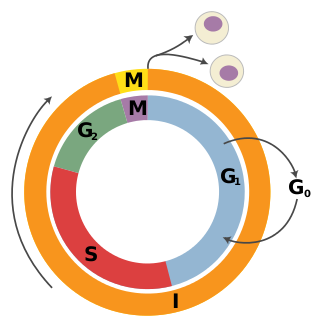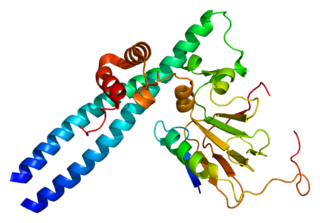
A tumor suppressor gene (TSG), or anti-oncogene, is a gene that regulates a cell during cell division and replication. If the cell grows uncontrollably, it will result in cancer. When a tumor suppressor gene is mutated, it results in a loss or reduction in its function. In combination with other genetic mutations, this could allow the cell to grow abnormally. The loss of function for these genes may be even more significant in the development of human cancers, compared to the activation of oncogenes.

Mouse double minute 2 homolog (MDM2) also known as E3 ubiquitin-protein ligase Mdm2 is a protein that in humans is encoded by the MDM2 gene. Mdm2 is an important negative regulator of the p53 tumor suppressor. Mdm2 protein functions both as an E3 ubiquitin ligase that recognizes the N-terminal trans-activation domain (TAD) of the p53 tumor suppressor and as an inhibitor of p53 transcriptional activation.

Apoptosis regulator BAX, also known as bcl-2-like protein 4, is a protein that in humans is encoded by the BAX gene. BAX is a member of the Bcl-2 gene family. BCL2 family members form hetero- or homodimers and act as anti- or pro-apoptotic regulators that are involved in a wide variety of cellular activities. This protein forms a heterodimer with BCL2, and functions as an apoptotic activator. This protein is reported to interact with, and increase the opening of, the mitochondrial voltage-dependent anion channel (VDAC), which leads to the loss in membrane potential and the release of cytochrome c. The expression of this gene is regulated by the tumor suppressor P53 and has been shown to be involved in P53-mediated apoptosis.

Transcription factor Jun is a protein that in humans is encoded by the JUN gene. c-Jun, in combination with protein c-Fos, forms the AP-1 early response transcription factor. It was first identified as the Fos-binding protein p39 and only later rediscovered as the product of the JUN gene. c-jun was the first oncogenic transcription factor discovered. The proto-oncogene c-Jun is the cellular homolog of the viral oncoprotein v-jun. The viral homolog v-jun was discovered in avian sarcoma virus 17 and was named for ju-nana, the Japanese word for 17. The human JUN encodes a protein that is highly similar to the viral protein, which interacts directly with specific target DNA sequences to regulate gene expression. This gene is intronless and is mapped to 1p32-p31, a chromosomal region involved in both translocations and deletions in human malignancies.

Transcription factor E2F1 is a protein that in humans is encoded by the E2F1 gene.

SHC-transforming protein 1 is a protein that in humans is encoded by the SHC1 gene. SHC has been found to be important in the regulation of apoptosis and drug resistance in mammalian cells.

Krueppel-like factor 6 is a protein that in humans is encoded by the KLF6 gene.

Transcription factor Dp-1 is a protein that in humans is encoded by the TFDP1 gene.

Polo-like kinase 3 (Drosophila), also known as PLK3, is an enzyme which in humans is encoded by the PLK3 gene.

Cytoplasmic tyrosine-protein kinase BMX is an enzyme that in humans is encoded by the BMX gene.

Eukaryotic translation initiation factor 3 subunit I (eIF3i) is a protein that in humans is encoded by the EIF3I gene.

Cyclin-G1 is a protein that in humans is encoded by the CCNG1 gene.

Monocarboxylate transporter 5 is a protein that in humans is encoded by the SLC16A4 gene.

CDKN2A, also known as cyclin-dependent kinase inhibitor 2A, is a gene which in humans is located at chromosome 9, band p21.3. It is ubiquitously expressed in many tissues and cell types. The gene codes for two proteins, including the INK4 family member p16 and p14arf. Both act as tumor suppressors by regulating the cell cycle. p16 inhibits cyclin dependent kinases 4 and 6 and thereby activates the retinoblastoma (Rb) family of proteins, which block traversal from G1 to S-phase. p14ARF activates the p53 tumor suppressor. Somatic mutations of CDKN2A are common in the majority of human cancers, with estimates that CDKN2A is the second most commonly inactivated gene in cancer after p53. Germline mutations of CDKN2A are associated with familial melanoma, glioblastoma and pancreatic cancer. The CDKN2A gene also contains one of 27 SNPs associated with increased risk of coronary artery disease.

Eukaryotic translation initiation factor 3 subunit L (eIF3l), less commonly known as EIF3EIP, is a protein that in humans is encoded by the EIF3L gene.

Denticleless protein homolog is a protein that in humans is encoded by the DTL gene.

Ligatin, otherwise known as eIF2D, is a protein that in humans is encoded by the LGTN gene. This protein is not a component of the heterotrimeric eIF2 complex, but instead functions in different pathways of eukaryotic translation.

Eukaryotic translation initiation factor 5A-2 is a protein that in humans is encoded by the EIF5A2 gene.

Monocarboxylate transporter 4 (MCT4) also known as solute carrier family 16 member 3 is a protein that in humans is encoded by the SLC16A3 gene.

Density regulated re-initiation and release factor (DENR) is a protein that in humans is encoded by the DENR gene.



















